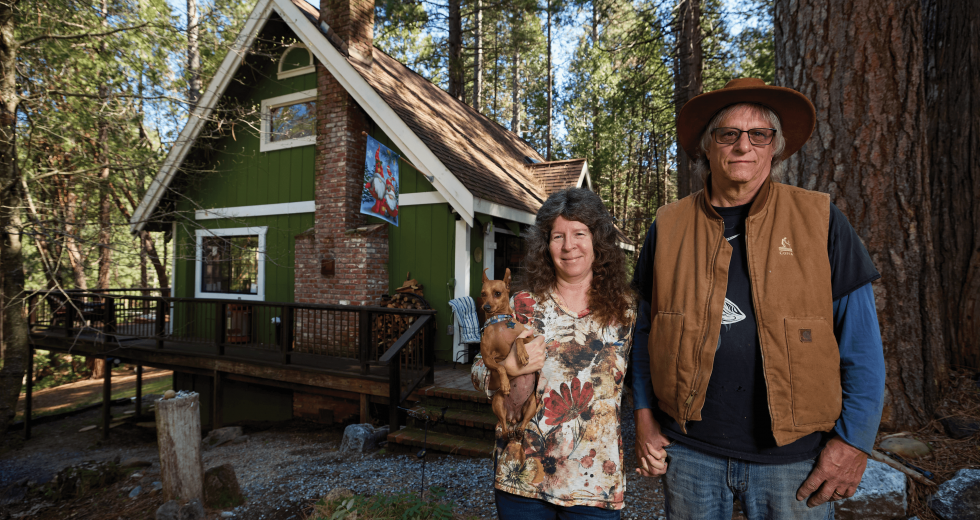California’s insurance crisis is damaging the housing market and more. Will legislators fix it before the next big blaze?
Kelly Knipe sells homeowners insurance and wishes he didn’t. He owns Sierra Diversified Insurance in Placerville, but in the last few years handling requests for quotes has been nothing but misery. The increasing severity and frequency of wildfires means nearly all homeowner policies in the foothills are written by California’s FAIR Plan, a state-created insurer of last resort for those who can’t get coverage elsewhere.
But even for a broker like Knipe, just getting through to the FAIR Plan for a quote has been a hardship. Until recently, getting someone on the phone could take two to five hours, though after the agency hired more staff, that’s down to a little over an hour, he says. And quotes are taking ever-longer to come in: Anyone who’s buying a house and needs one in fewer than 30 days to go to closing is in trouble, he says.
When quotes do come in, the terms are worse, with huge premiums and often high deductibles. Knipe recently interrupted a long-planned weekend away to return to deal with a real estate transaction that was about to fall through because the lender wouldn’t accept the high deductible the plan was requiring. He’s hearing of other sales collapsing because of similar problems.
Kelly Knipe, owner of Sierra Diversified Insurance, tries to help
homeowners who are struggling to find homeowners insurance in a
tough market.

People call him, desperate to find a broker who will help them get a quote. But if they’re in a time crunch, he has to say no. “They’re thinking of the old days when insurance companies wanted your business,” he says. “Now they don’t.”
Fire insurance in the foothills is in major crisis, he says: “I don’t think people have a grasp on how bad it really is until they get into the situation. Then they find out quickly.”
Thousands of homes have been lost to wildfires in California during the past decade. The 2018 Camp Fire in the Butte County town of Paradise remains the most destructive fire in California history, wiping out nearly 19,000 structures — an entire community.
Homeowners and businesses in wildland areas are scrambling for coverage as insurers boost prices, drop customers or leave the state altogether. Last fall the state’s insurance regulator devised new rules designed to bring companies back, but so far they haven’t returned. Looming over it all is a doomsday scenario — a catastrophic fire that causes millions in losses that the FAIR Plan can’t cover, collapsing the market altogether.
Increasing pressure to sell and move
The consequences of the insurance crisis for business and real estate in the hardest-hit areas could be dire. Home buyers are still looking but are trimming their sales on what they can afford because they have to factor in potentially huge insurance premiums, says Kili Rahbeck, owner of KOR Realty in South Lake Tahoe and a past president of the South Tahoe Association of Realtors. The second-home market is the most affected because those buyers have more options. “A lot of those would-be homeowners in the area are just saying, ‘Fine, we’ll just go somewhere else,’” Rahbeck says.
United Policyholders, a nonprofit consumer group, ran surveys of California homeowners in the last two years. “We’ve had quite a few people say, ‘I feel increasing pressure to sell this house because I can’t keep up with the insurance,’” says Amy Bach, the group’s executive director. “I’m sure property values are starting to be affected.”
Climate change has made another big fire season inevitable. Since 2000 the state has gotten much drier and hotter, according to a 2023 report from Moody’s Investors Service. The period of 2020 to 2022 was the driest three years on record, breaking the old one that ran from 2013 to 2015, according to the California Department of Water Resources, and the counties northwest of Sacramento are some of the driest in the state. It’s also hotter, and high summer temperatures correlate with large fire years.
Meanwhile, more Californians than ever live in the “wildland-urban” interfaces — places where urban areas and the forest run up against each other, making them vulnerable. From 1990 to 2010 there was a 4 percent increase in the number of houses in the wildland-urban interface; at least 11 million Californians live in those areas, a quarter of the state’s population. Counties with some of the highest percentages of those areas are concentrated in Northern California, including in and around Sacramento, according to a 2022 study in the journal Nature. More people in high-risk areas is the No. 1 driver of rising insurance costs, according to a 2022 report by analytics firm Verisk.
The result: Property insurers are losing money. In 2017, they paid out well over 200 percent of the premiums they took in, and in 2018 it was just under 200 percent — $36 billion in losses overall. Nationwide, home insurer profits averaged 4 percent over the last 10 years. In California it was negative 6 percent, according to the state’s Department of Insurance.
Still, it’s not just climate change. Insurers say the rules requiring state approval of rate increases and forbidding them from using projections of coming years’ risks to adjust rates is driving them out. David Russell, director of Cal State University-Northridge’s Center for Risk Management and Insurance, didn’t respond to Comstock’s requests for comment. But he said in February that homeowners are having trouble getting insurance because state regulators haven’t let premiums keep up with rising costs.
‘A ticking time bomb’
Companies are responding by pulling back from California — a classic case of how markets respond to a price cap. Since 2022, seven of the top 12 home insurers in the state have paused or restricted new business. State Farm announced in March it will not renew more than 72,000 insurance policies over the next year. “This is a real crisis,” California Insurance Commissioner Ricardo Lara told Eyewitness News in Los Angeloes. Now the approval rate for a new homeowners insurance policy statewide — risky area or no — is less than 10 percent, Scott Sanchez of Lewis Sanchez Insurance in Sacramento said at a seminar for realtors last October.
And even when someone can find a company to write a fire insurance quote, the rate can be stratospheric. Kevin Cookson, president and CEO at Maven Risk Management & Insurance Brokers in Grass Valley, got a quote in early February on a client’s $750,000 house: $35,000 a year.
“They’re thinking of the old days when insurance companies wanted your business. Now they don’t.”Kelly Knipe, Owner, Sierra Diversified Insurance
That’s why an increasing number of homeowners are forced into the California FAIR Plan. The plan was created in 1968 by the state. It’s a privately run company operated by the state’s insurers that approves nearly all applicants. As of September 2023, the number of homeowners in the FAIR Plan was growing 20 percent a year, according to the state’s Department of Insurance. A FAIR Plan representative said at a recent United Policyholders’ event that the plan is getting about 900 new applications a day, says Bach.
That increasingly top-heavy Jenga tower threatens to topple: If a big, destructive wildfire hits an area with a lot of FAIR Plan customers, the losses could be catastrophic, Robert Gordon of the American Property Casualty Insurance Association told Congress last November. “That is a ticking time bomb,” he said.
The insurance crisis is one more element pushing some out of California. Cindy Worthington, 56, and her husband Ed Rapp, 66, own an 1,150-square-foot cabin in the village of Pioneer in Amador County. They bought it in 2019 for about $250,000 after leaving Lake County when the 2015 Valley Fire took out most of the 175 homes in their development, including theirs.
When they bought the cabin in Pioneer, only two companies would give them a quote, and they ended up paying $4,500 a year for fire insurance and a wrap-around plan. But the company they chose dropped their coverage two years later, forcing them onto the FAIR Plan. Since then, their premium for fire and wrap-around insurance has jumped to $7,800, which they pay every spring in one big check.
Retired and on a fixed income, they wonder how long they can hold on. They need a new roof but can’t afford one, Worthington says. “What if I have something major come up? It’s really a kick in the gut.”
She’s hearing talk of people selling and moving out of state. “But then it’s hard to sell your house because nobody else can afford (the insurance) either,” she says. “Everybody has the same story of ‘Whoa, what am I going to do now?’”
Businesses are forced into the FAIR Plan too. It’s still possible to get property insurance on commercial buildings in downtown Grass Valley, says Cookson, but outside city limits, you can’t get a policy other than the FAIR Plan.
What’s at stake in 2024
What happens this year might determine whether the state ever returns to a functioning home insurance market.
After state lawmakers took no action to fix the problem in 2023, last September state insurance commissioner Ricardo Lara stepped in. His department’s new rules require companies to write more policies in areas threatened by wildfires and promise expedited state review of requests by insurance companies for rate increases. The rules also mandate that insurers must give discounts on premiums to homeowners who make “defensible space” changes intended to protect their property from fire risk, like installing an improved roof or clearing vegetation and debris from under decks and from a 5-foot buffer around the house.
Still, that doesn’t help homeowners who are being refused altogether. Rahbeck talks to those who’ve spent thousands of dollars on steps like those and are still having their policies canceled. “Homeowners say, ‘You know, I’ve cut all these trees and more, and (the carrier) goes, ‘Yeah, well, we don’t care.’ It’s like, you asked us to do this. And now it doesn’t matter,” says Rahbeck.
So consumer advocates are pushing for state Senate Bill 672, which would require insurers to not just offer discounts but guarantee coverage to homeowners who take those steps. They claim that insurers have no reason to deny them coverage and cite a 2019 CAL FIRE analysis of 2017-2018 wildfires, which found that buildings not compliant with state defensible space recommendations were five times more likely to burn than those that were.
But some state legislators say hardening homes — taking steps to make them more defensible against wildfires — isn’t enough. Part of the solution is stiff market medicine: letting insurers charge more so that additional companies are attracted to enter California, creating more competition. “It’s a tough pill to swallow to pay more in premiums to avoid even greater premiums or unavailability of insurance. But that may be part of the solution,” state Senator Bill Dodd, a Democrat who represents Sacramento County and five others to the north and west, wrote in a January op-ed.
Like the state’s home insurers themselves, Knipe questions whether he should stay in the business at all. He’s trying to transition to selling financial services and life insurance. “I’ve been really, really second guessing — you know, trying to get out of it,” says Knipe. “But at the same time, so many people need my help, and it’s hard to say no.”
Get all the stories in our annual salute to women in leadership delivered to your inbox: Subscribe to the Comstock’s newsletter today.
Recommended For You

The Design of Dining
Restaurant owners put as much thought into their interiors as they do their food
Comstock’s took a look at three restaurants in the Capital Region where the interior design is as thoughtfully conceived as the cooking, places so special they’ll have you second guessing yourself the next time you’re tempted to order takeout.

What Women Bring
Women reflect on their road to leadership
These women’s paths have led them to positions of influence in their fields, and in some cases, they’ve made history in their roles.

Anna Judah: Far More Than Theodore Judah’s Victorian Housewife
Through her artistry, she brought the transcontinental railroad to life — before it was built
You wouldn’t know that a tragic love story led to the railroad that connected the East and West coasts for the first time.




